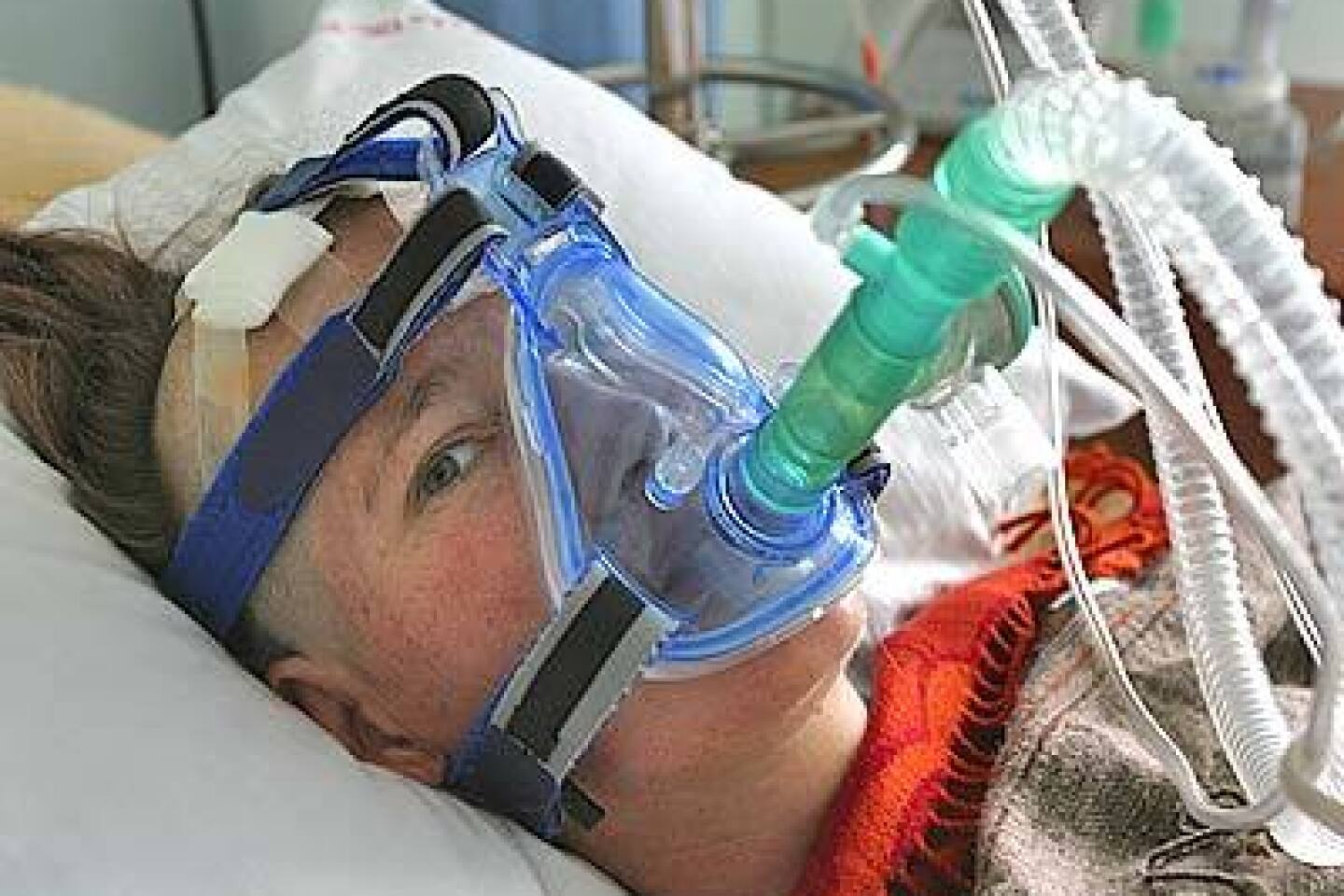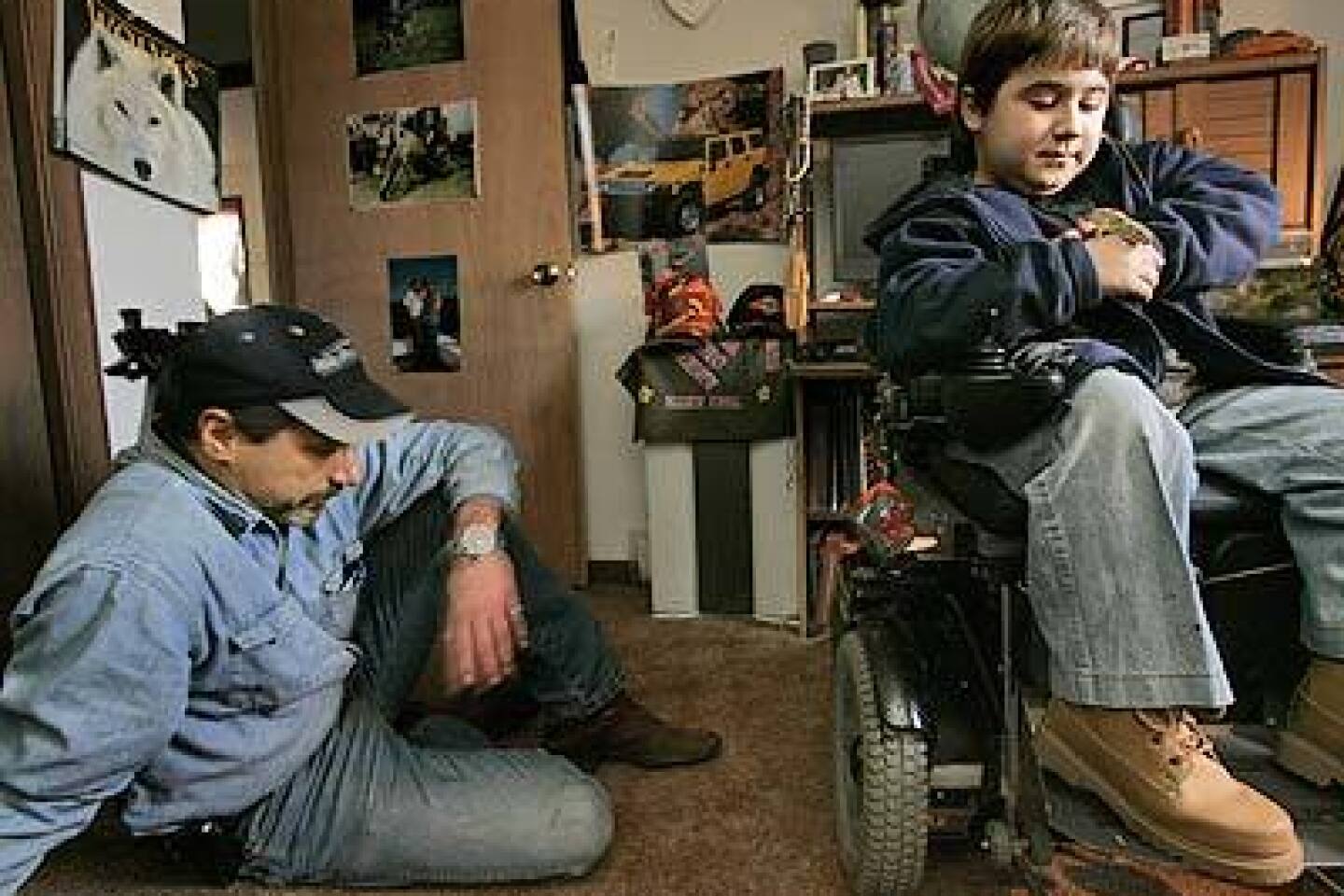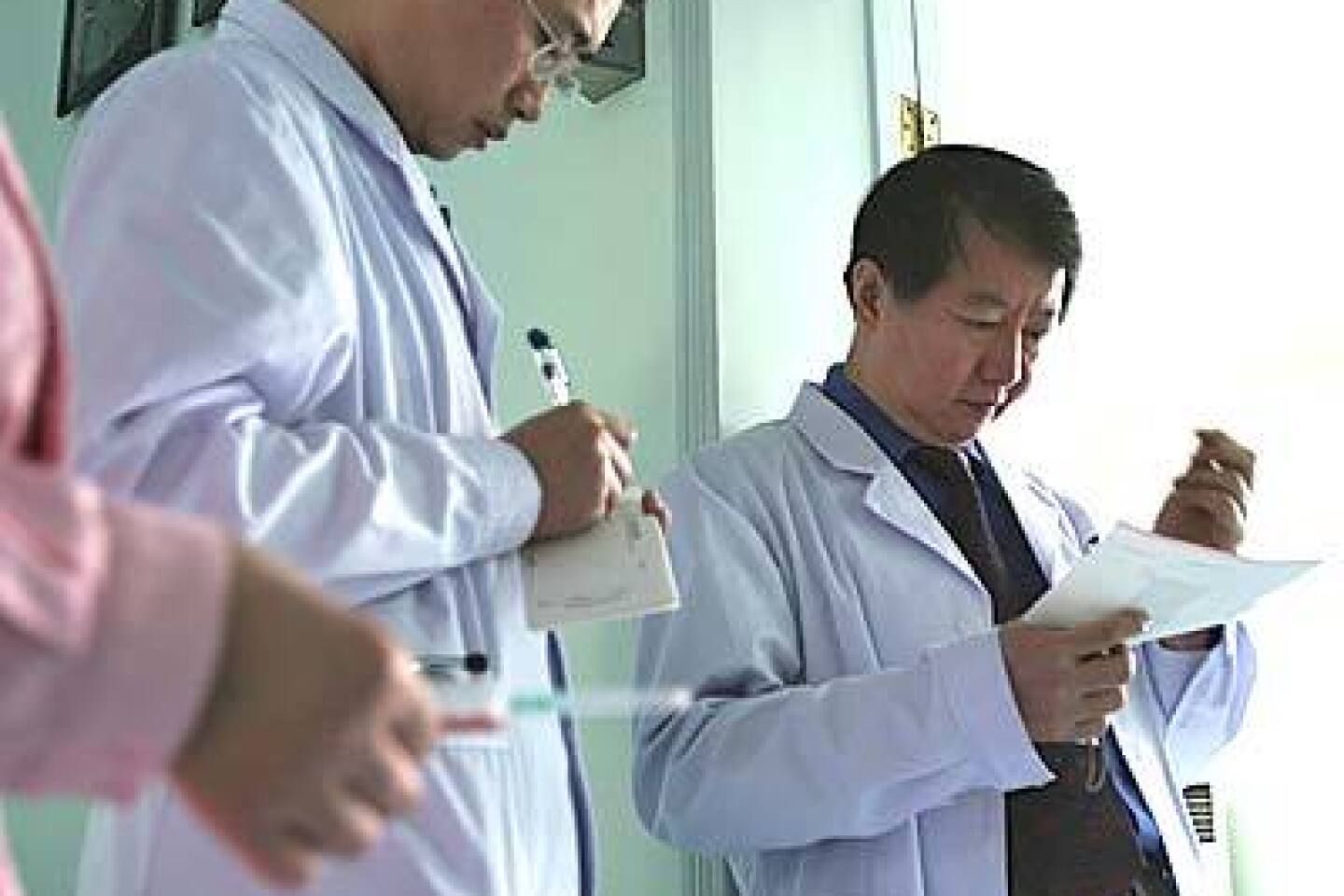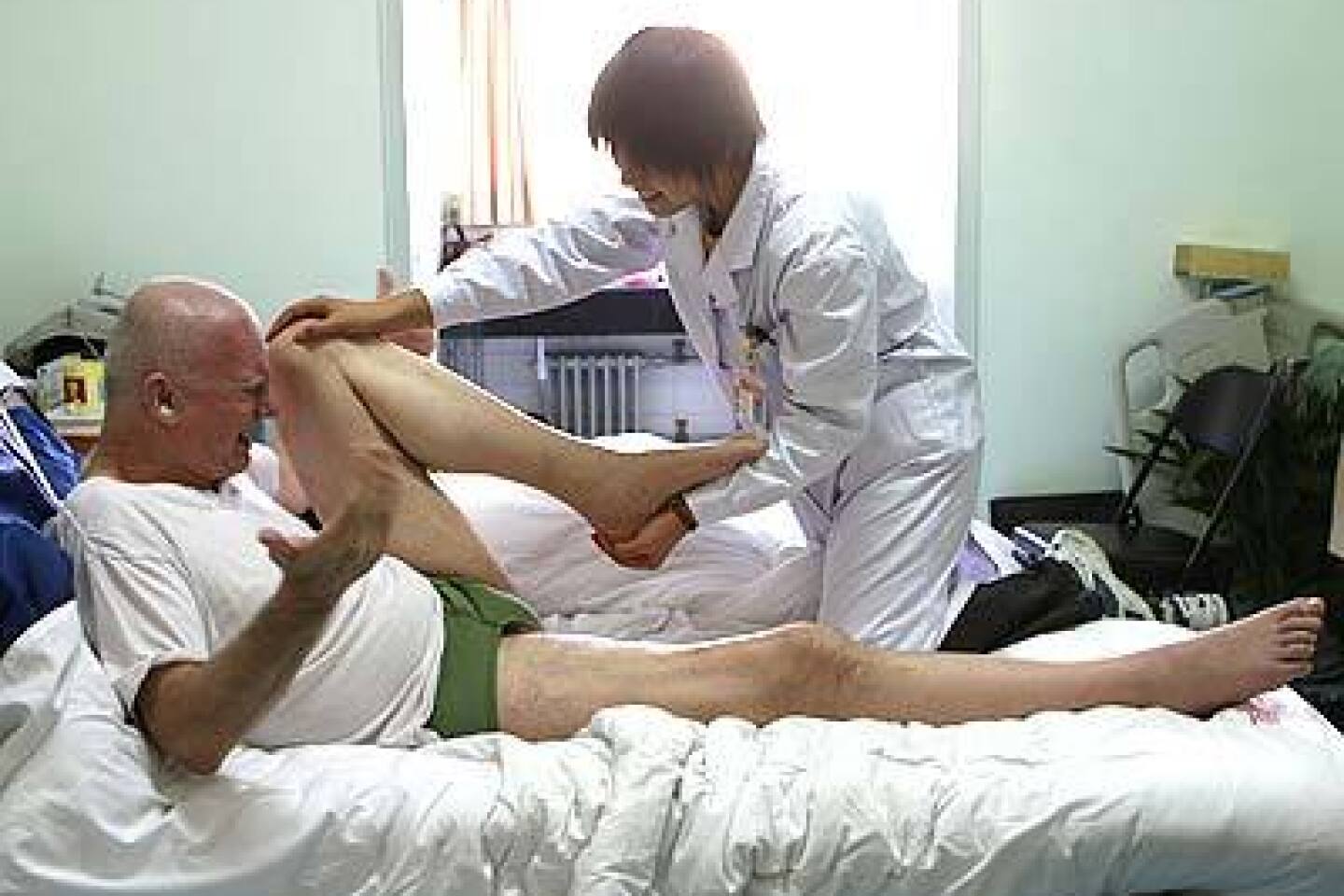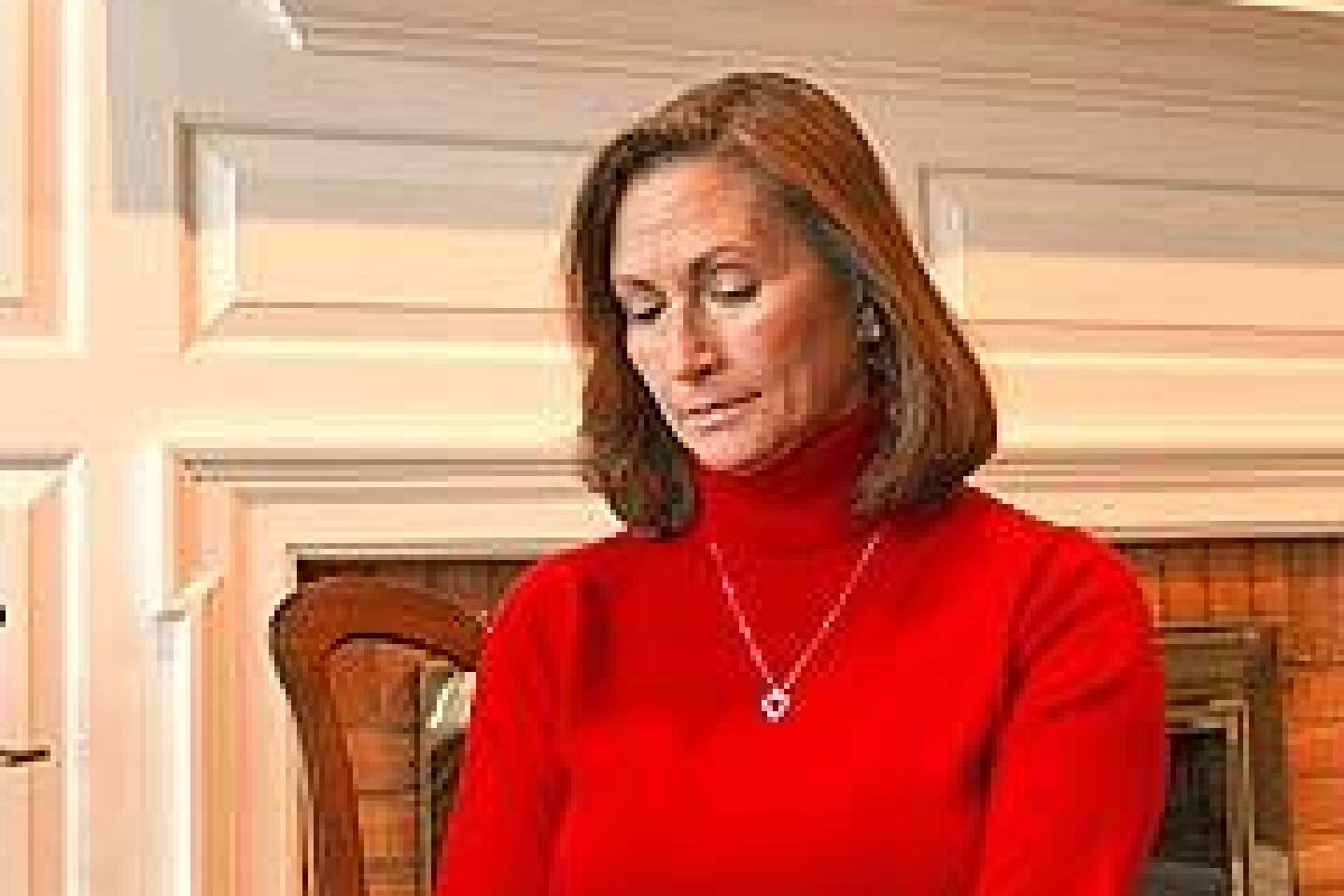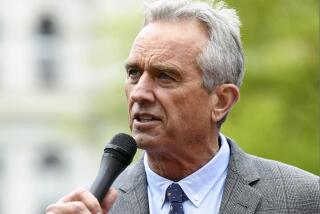A desperate injection of stem cells and hope
- Share via
Alone at his computer, drool sliding down his chin, Tom Hill searched the Internet for anything that could save him.
His 55-year-old body was gradually shutting down. His muscles twitched uncontrollably. He could no longer talk, so he scribbled notes to communicate with his wife, Valerie.
Seven months earlier, he had been diagnosed with amyotrophic lateral sclerosis, also known as ALS or Lou Gehrig’s disease — an incurable deterioration of the nervous system that spares the cognitive parts of the brain, leaving its victims sharply aware as they slowly die.
The doctors told him there was no way to reverse the disease — no drugs, no surgeries, no other therapies.
Tom refused to listen.
He had been a successful real estate developer in Atlanta, a hard charger who always got things done his way.
Now, he spent most of his time in a makeshift study above the garage, searching hour after hour.
Valerie could hear Tom’s muffled movements. She rarely interrupted him. After nearly 29 years of marriage, it pained her to see him like this.
She knew there was little hope, but there was no point in arguing. She threw herself into the final preparations for their daughter’s wedding and left Tom alone to search.
In the spring of 2003, he found https://www.biomark-intl.com .
BioMark International offered a stem cell injection for a variety of illnesses, including Parkinson’s disease, muscular dystrophy, depression and ALS.
“All ALS research now cites the promise of stem cells as the only answer,” the website said.
Tom had been reading about stem cells for months and knew them to be the next frontier of medicine, the primordial cells that could become unblemished tissue of any type. He was convinced they could replace the deteriorating nerve cells in his body.
He pored over BioMark’s material, dozens of pages of patient testimonials, scientific references and news reports on the vast promise of stem cells.
Could this be his chance to be reborn?
Valerie could hear her husband’s printer churning out page after page.
“It is worth a try,” he scrawled in the margin of one printout.
ENTREPRENEURS ON SCIENCE’S FRONTIER
Tom Hill was just the type of patient BioMark was looking for.
The company was launched in the summer of 2002, less than a year before Tom found its website. It began small, in a rented condominium shared by its founders, Laura Brown and Steve van Rooyen, just a few miles from Tom’s house.
At first, the company survived patient to patient, each paying as much as $21,000 per treatment.
Word was spreading. It was a good time for a stem cell business.
The once exotic science was in the news almost daily. In August 2001, President Bush allotted federal funds for stem cell research but said they could not be spent on the study and development of new lines of cells from human embryos. It was a compromise to address the concerns of religious conservatives and others who opposed any destruction of human embryos.
The restrictions came under attack from high-profile figures, including former First Lady Nancy Reagan and actor Christopher Reeve, fomenting a national debate that turned “stem cell” into a household term.
Reports of each new scientific advance circulated rapidly — in the media and on Internet message boards for people with incurable diseases. Stem cell clinics began popping up in China, Ukraine, Barbados and other places.
Brown and Van Rooyen built their business on the idea that science had already proved the therapeutic power of stem cells. BioMark was simply making it available to the world.
The company had a scientific advisory board, a professional-looking website and doctors to administer the therapy in Atlanta.
“When something this powerful, this beautiful, is laid in your hands, in your path, you give everything you have to it,” Brown said in an interview with The Times last fall.
At least 220 patients had received BioMark injections, she said.
The therapy, as advertised, was simple: an injection of 1.5 million stem cells in the abdomen. Everybody got the same type of cells, regardless of their disease.
“Once in the body, cells migrate to the site of the disease and begin producing the needed cells,” explained a BioMark information packet.
BioMark cells, Brown told patients, were free from the “right-to-life issues” slowing the development of stem cell cures in the U.S. The cells did not come from embryos, but from blood harvested from umbilical cords after childbirth.
One BioMark brochure carried a disclaimer that the treatment was not approved by the Food and Drug Administration.
But some patients saw that as a badge of honor. Someone was working to help them, even if that help ran afoul of the government.
It infuriated Tom that politics had trumped science.
“People suffering from disease are told they have to wait for their cures,” he wrote in a letter to his U.S. senators. “Many of these patients do not have time to wait and a research delay could be a death sentence.”
Tom created a website to protest the federal restrictions. After 25 years as a Republican, he renounced his party membership.
He told Valerie about BioMark and instructed her not to tell his doctors.
She didn’t know what to make of all this. She had never heard of anyone being cured of ALS, and she gingerly questioned his plan.
Tom stabbed at the keys on his voice synthesizer. An electronic retort pulsed back at her: “I’ve done a lot of research.”
He felt sure: This was science.
A DISCOVERY WITH GREAT PROMISE
It began 50 years ago with the discovery of an odd lump on the scrotum of a lab mouse.
Researchers at the Jackson Laboratory in Bar Harbor, Maine, were investigating whether cigarette paper could cause cancer. One lab mouse had an unusual tumor.
Most tumors are made up of one type of tissue that grows out of control. But this one was a grotesque clump of budding muscle, bone, nerves and fat.
It was biology gone haywire.
After many experiments, the scientists found a smattering of unfamiliar cells mixed in this mad stew of life.
These tumor cells, they surmised, were transforming into other tissue types.
The cells gave scientists a chance to look at one of the most mysterious processes of life.
All the complexity of the human body — hearts, lungs, brains, limbs — starts from a single fertilized egg. As it divides, an unknown set of biochemical signals tells the multiplying cells to differentiate into the diverse tissues of the body.
When the cells are primitive, they have the ability to become any tissue — “pluripotent” in medical terminology.
The mouse tumors offered a crude glimpse of these “stem cells” and their power to transform.
It would be decades before researchers possessed the technology to find them in embryos.
In 1981, scientists isolated embryonic stem cells in mice and successfully grew them into a kind of suspended animation in which the cells would indefinitely divide but not differentiate.
They later found that slight chemical changes could make the cells suddenly transform into a mishmash of tissue.
It took 17 more years before researchers at the University of Wisconsin isolated the cells from days-old human embryos.
The floodgates of medical fantasy were thrown open.
If scientists could decode the complex series of biochemical signals used to command the cells, they could create any type of tissue.
Doctors could grow new nerve fibers to patch a severed spine. They could make new organs to replace damaged ones without fear of tissue rejections. They could grow brain cells to help patients with Alzheimer’s disease.
Science has made some progress.
At the National Institutes of Health, mouse embryonic stem cells were transformed into neurons that made the brain chemical dopamine. The new cells were used to treat symptoms of Parkinson’s disease in rats.
At Stanford University, the same type of cells was used to make insulin-producing cells that kept diabetic mice alive.
At UC Irvine, human embryonic stem cells were transformed into nerve-wrapping cells known as oligodendrocytes, which helped rats with spinal cord injuries.
But scientists say the complex biochemistry of humans means that medical therapies are years, if not decades, away. Therapies could lead to cancer if the stem cells migrate to the wrong place.
There are currently no trials underway for human therapies using embryonic stem cells in the U.S.
“It’s still in its infancy,” said Gail Martin, a developmental biologist at UC San Francisco who was one of the first scientists to isolate embryonic stem cells in mice.
A CONFIDENT MAN, A CONFIDENT PATIENT
Valerie had never really noticed how life was balanced on a knife point, ready to topple her into darkness at any moment.
She was a 23-year-old stewardess for Delta Airlines when Tom spotted her at a wedding in 1973. Eleven months later they were married — and on the path to the good life they both wanted.
Over the next three decades, they built a house in one of the toniest Atlanta suburbs, bought a vacation home on nearby Lake Burton, joined a country club and took ski trips to Aspen. Their two children attended private schools. Tom pushed hard for these things.
He was always so sure. That was one of the things that had attracted Valerie. He had a smooth, confident voice that put people at ease.
His voice was the first thing to go.
Valerie noticed in the spring of 2002 that his speech had begun to slur ever so slightly sometimes, as if he were drunk. She hoped the doctors were right, that he was suffering from allergies or stress from his business.
In October, a doctor told her that Tom probably had no more than a few years to live. She let out a scream. The doctor put her on an antidepressant.
Tom had bulbar ALS. The disease starts in the cranial nerves that control the lower face, tongue and palate, reaching the vital organs more quickly than a slower-killing variety that starts in the limbs.
Tom approached his illness like another real estate deal.
Early on, he walked into the office of Dr. Jonathan Glass, a neurologist who heads the ALS Center at Emory University, and announced: “I’m going to help you cure me by raising millions of dollars for your research.”
Valerie didn’t want to stand in his way. Still, there were so many things to do and talk about in the time Tom had left. There was their daughter’s upcoming wedding, and plans for their son, who was in college.
Tom didn’t want to discuss those things.
One day, he presented Valerie with a stack of printouts on BioMark.
The information seemed to make sense — until she started reading the patient testimonials. One stood out: a 26-year-old ALS patient who had added 20 pounds of muscle in the two weeks after his treatment. “He feels incredible and is regaining strength,” it said.
Valerie was dumbfounded. “This is a joke,” she said. “If this is true, then everybody should be doing it around the world.”
But it was futile to argue with Tom and always had been.
He was taking 28 pills and lozenges a day. No therapy seemed too outlandish. He tried curative magnetic insoles. He spent two weeks in Tijuana getting ozone treatments that were supposed to remove toxins from his body.
By the spring of 2003, he had dropped to 146 pounds, down from his healthy 172.
There was still time for hope. In June he summoned the energy to walk his daughter, Meredith, down the aisle at her wedding. He danced with her to the song “My Girl” while tearful guests looked on at the reception.
Tom threw himself into setting up a BioMark injection.
“They normally charge $21,000 but they want to be listed on my website,” he wrote on a notepad.
He got the fee down to $10,000.
At least he had bargained, thought Valerie, who was starting to worry about all the money that seemed to be disappearing into a black hole of cure-alls.
On July 18, Tom received an e-mail from BioMark. For the time being, the closest place he could receive an injection was Toronto.
“I Am spending so much for my HEALTH NOW,” Tom wrote on instructions to wire the $10,000 to BioMark’s account at Bank of America in Atlanta.
The next week, Tom and Valerie flew to Toronto and took a taxi to a clinic. In the waiting room, Dr. Christopher Goddard was finishing up with another patient, a man with multiple sclerosis who had just received an injection.
For the next hour and a half, Valerie grilled the doctor about his credentials and the treatment. He told her he was a physician with a doctorate who worked at Lifebank Cryogenics Corp., a Canadian company that stores umbilical cord blood. BioMark paid him to fly from Vancouver, British Columbia, to administer the injections.
There was still time to back out and get their money returned.
Valerie looked at Tom hunched in a wheelchair. She knew this was his last hope.
“No, we’ll do it,” she said.
Valerie was still skeptical, but she felt a little better. Goddard seemed to know what he was talking about.
The stem cells could be injected into a vein, which BioMark said would bring the biggest results in three months, or into the fat of the abdomen for improvements that would come later but last longer.
Tom decided he would split the cells and do it both ways.
From the week he was diagnosed, he had told everybody that he would survive. He had fought so hard. This was a cure whose power nobody could deny.
At that moment, Valerie decided to duck out for a quick lunch.
Alone with the doctor, Tom felt the sting of two needles. In a few minutes, it was over.
Restoration had begun, he thought.
BIOMARK’S PLAN TAKES SHAPE
Laura Vanessa Brown, a co-founder of BioMark International, is 34 years old, tall, thin and blond.
“My background wouldn’t naturally point me in this direction,” she said in a telephone interview from a location she refused to specify. “I modeled for a long time.”
Her father, Douglas Brown, an investment advisor in Waxhaw, N.C., said that Laura’s job as a runway model sent her around the world through much of the 1990s. He said that she grew interested in nutrition and alternative medicine while watching her weight.
Laura Brown double-majored in speech and in radio and television at the University of North Carolina at Chapel Hill. She said her science education came unconventionally.
“I got to do a lot of studying and reading and writing while I was bouncing around not using my brain for work,” she said.
In the late 1990s, she said, she landed in Los Angeles and studied yoga.
There, she met Steve van Rooyen. He had no science degree either, Brown said.
They became partners and headed to Atlanta in 2002 to work with Mitchell Ghen, an osteopath who had once treated Brown’s father and had become interested in stem cells from umbilical cord blood.
But after a few months, the pair broke away to form BioMark, eventually relocating to an apartment in Miami Beach.
They worked hard to build their business, visiting doctors and alternative medicine practitioners to explain their treatment.
Dr. Alawode Oladele, an Atlanta oncologist, said he met with Brown at an Atlanta hotel, where she questioned him about cancer treatments.
Brown told him that BioMark had a team of scientists and reams of unpublished data showing the effectiveness of its treatment. Oladele was impressed.
That was the last he heard from BioMark.
Later, he was perplexed to see himself listed on BioMark’s website as a member of the scientific advisory board. He found it odd but figured it didn’t really hurt him.
Five other people said they were also surprised to find themselves posted as scientific advisors.
BioMark sent blood to Howard Wajchman, an Atlanta immunologist, who said he isolated the stem cells and sent them to doctors working with the company.
Dr. Dowman Covington, who worked at an Atlanta clinic, said Brown and Van Rooyen convinced him that a 1997 Georgia law — the Access to Medical Treatment Act — would allow him to try experimental therapies for people with incurable illnesses.
One of his first patients, he said, was Laura Brown, who wanted the cells as an anti-aging treatment. It was reassuring that Brown seemed to believe so strongly in the therapy.
Covington said he injected 46 patients for multiple sclerosis, ALS and cancer, receiving $300 or $400 per patient.
But after several months, he became suspicious when BioMark sent him a patient with a severed spinal cord, a condition that he saw no point in treating with the cells. He stopped working with the company in the spring of 2003.
BioMark started sending Atlanta patients to a clinic in Canada.
In October, the family of Craig Lauver, an ALS patient in Mifflintown, Pa., who was convinced that a BioMark injection could cure him, called the FDA with concerns about the company.
The FDA began a fraud investigation, persuading the Lauver family to help set up an undercover operation. Craig Lauver’s brother, Nelson, said he asked BioMark to send somebody to inject the cells.
When a BioMark representative arrived from Arizona on Nov. 14, an FDA agent was there posing as Nelson’s business colleague. The representative talked about the therapy, while two FDA agents in a bedroom controlled a video camera hidden in a lamp. After about 20 minutes, they entered the living room and pulled out their badges.
The FDA questioned and released the BioMark representative.
The same day, the FDA raided BioMark’s office in Miami Beach, according to an e-mail the company sent to a patient.
The FDA froze BioMark’s Bank of America accounts, which held $264,554.12, court documents show.
The company was shut down, but on the Internet it still looked like a thriving business. The website was dense with links to news articles about stem cells and diseases. The words “BioTech Advances” were bannered across the top, alongside the image of somebody peering into a microscope. A DNA double-helix spiraled down the left. There were links for “Research and Development,” “Scientific Support” and “Testimonials.”
Research by Catherine Verfaillie, the website said, proved the power of BioMark stem cells.
But Verfaillie, director of the Stem Cell Institute at the University of Minnesota, explained in a March 2004 letter to the FDA that her work had been misrepresented.
“The information has no scientific credibility and it may mislead people who are seeking treatment and cures for serious diseases,” she wrote of the BioMark website.
Several stem cell experts who reviewed the website for the Los Angeles Times agreed.
Cord blood stem cells have been used to treat some blood diseases and to rebuild the blood-forming system after chemotherapy. But scientists doubt they would be useful for neurological diseases because current evidence suggests that any ability to transform into non-blood cells is limited.
On the Internet, satisfied BioMark customers described improvements, such as smoother skin, better sleep and more energy — sometimes within hours of their injections. Scientists leave open the possibility that the patients are experiencing more than the placebo effect, but without controlled clinical trials it is difficult to know what is happening.
“This is just evil,” said Lawrence Goldstein, a professor of cellular and molecular medicine at UC San Diego School of Medicine.
Dr. Irving Weissman, a Stanford University professor and the first person to isolate blood-forming stem cells, concluded: “It’s totally disgusting.”
After the FDA search, Brown and Van Rooyen left the United States.
WAITING FOR THE CELLS TO WORK
Amonth after his injection, Tom swore that it was easier to close his mouth.
Valerie was skeptical, but Tom told her to be patient. “Six to eight weeks,” he would say, echoing BioMark’s claims about how long it would take to start seeing the biggest benefits.
By the two-month mark, his breathing had plunged to 46% of normal.
When Tom could no longer climb the stairs to his office, he spent his days in a living room recliner, a computer in his lap.
His son, Thomas, had taken the year off from college to help care for his father. Thomas struggled now to transfer him in and out of the lift installed in the stairwell. His father’s body was turning to dead weight.
At this late stage, Valerie wished that Tom could help patch the holes of their life — apologies, advice for their children, regrets, kind words that could help her carry on without him.
She begged him to make peace with his life.
“Why are you so mean to me?” Tom typed on his synthesizer. “You want me to die soon.”
“No, we want you to talk with us,” Valerie said. “Isn’t there something you want to tell us?”
Tom just shook his head.
She asked whether he wanted to be buried or cremated. He turned up the volume on the television to drown her out.
One night Tom plowed his wheelchair into furniture, knocking over lamps and chairs. Valerie called the police, telling them that he had tried to ram into her too.
After that, she refused to guard his secrets and told Dr. Glass about the stem cell treatment.
The neurologist understood. Tom was not his only patient who had sought unproven stem cell therapies abroad.
Valerie asked a lay minister from her church to talk with her each week.
All that fall, a pungent odor wafted through the house — a brew of Chinese herbs that Tom poured into his feeding tube.
In early November, Tom received an e-mail from BioMark stating that the board of directors wanted to offer him a second treatment. He would only be required to pay about $1,000.
“Please do not contact them and tell them it doesn’t work,” Tom typed in a message to Valerie. “I need anything now to help me and I will try anything.”
Perhaps the first stem cell injection just needed a boost. He was ready to wire the money as soon as BioMark scheduled an appointment.
Then the news arrived. Tom showed Valerie the e-mail from the FDA. BioMark was under investigation for fraud.
“I guess you won’t be going for that second treatment,” Valerie told Tom.
He lowered his head.
He still believed in BioMark, but there was nothing he could do on his own. Valerie could barely listen to him anymore.
She dug up the number for the Canadian doctor who had injected Tom, and demanded a refund.
Dr. Goddard sent $1,920, which he told her was his fee from BioMark. He did not return several phone calls from The Times.
The money arrived with a note saying, “I love my patients.” There was also a book, the 1969 classic by Dr. Elisabeth Kubler-Ross, “On Death and Dying.”
Valerie glanced at the book and deposited the money.
A RESOLUTION WITH NO PEACE
On March 23, 2004, Tom Hill died at Haven House Hospice in Atlanta. He was 56.
At a memorial service at Northside United Methodist Church, old friends spoke about their fraternity days at the University of Georgia. The minister remembered how happy Tom had been to walk his daughter down the aisle at her wedding.
Valerie decided to have his body cremated. Half his ashes were scattered on Lake Burton. Valerie plans to disperse the rest in a memorial garden at their church. For now, they are on a shelf in his office, surrounded by pictures of the multimillion-dollar office complexes he had built around Atlanta.
Two months after Tom died, Valerie put a recording of his memorial service into a cassette player at home. The last two years had nearly destroyed her memories of their marriage. The old stories helped. She replayed the tape every few days.
“Eventually, I’ll hopefully be able to remember the good times,” she said.
She has begun training to become a Stephen Minister, a church counselor like the woman who had helped her through Tom’s final months.
The FDA recently sent her a check for $6,896, part of the money the government seized from BioMark. The company remains under investigation.
One afternoon in December, Valerie returned home to find a message on her answering machine from BioMark.
It was for Tom.
Valerie didn’t know it, but the company had set up an office in London and found doctors in Tijuana and Rotterdam, the Netherlands, to start administering their injections again. It set up a Swiss bank account to receive payments from patients.
The caller said she would phone back but never did.
A NEW SEARCH FOR HOPE
The patients arrive every few weeks at the Corporativo Oncologico in Tijuana — Americans slumped in wheelchairs, hobbling on crutches or carried by loved ones toward the stem cells inside.
The clinic’s main business is providing low-cost radiation treatments. But recently Dr. Armando Garcia, the head of the clinic, began administering stem cells for BioMark.
He stepped into the waiting room with an orange-and-white bag labeled “biohazard.” He reached into the bag and pulled out a frosted vial.
“These cells are very good,” he said.
Marsha Weeks arrived from Anacortes, Wash., in September, hoping to ease her bouts of pain from multiple sclerosis. Living on Social Security, the 29-year-old single mother maxed out her credit cards to pay for a single $10,000 treatment.
A few weeks later, 25-year-old Richard Welsh leaned into his crutches and ascended the ramp to the clinic. He prayed the cells could repair his spinal cord, crushed in a car accident five years earlier.
His hometown, Klemme, Iowa, had rallied behind him. A dentist donated electric toothbrushes for a fundraiser. The local Wal-Mart chipped in $750.
Greg Evans journeyed to Tijuana from Robesonia, Pa., hoping to save his only child. Eleven-year-old David was withering from Duchenne muscular dystrophy, a fatal degenerative disease.
“We’re staking our lives on this working,” Evans said.
More to Read
Sign up for Essential California
The most important California stories and recommendations in your inbox every morning.
You may occasionally receive promotional content from the Los Angeles Times.
